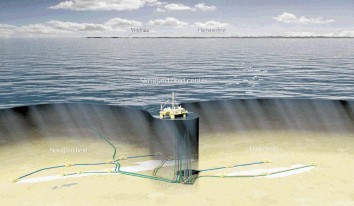
Ice, extreme temperatures and a vulnerable environment are all surmountable challenges as drillers set out to hunt for oil in a new area of Norway’s Arctic Barents Sea, according to Statoil and other explorers.
Studies by Statoil and 15 other companies such as Shell show there have been only a “few days” of sea ice in the northernmost blocks since 2003, and south of that even less, said Aashild Tandberg Skjaerseth, chair of the Barents Sea Exploration Collaboration, a venture set up by the companies.
It’s also unlikely that any spill would reach the polar ice cap as oil and sea ice tend to drift in the same direction, she said.
“Our main conclusion is that there is no health, environmental or safety challenge that is so significant that it can’t be appropriately mitigated,” Skjaerseth said.
The findings were handed over to authorities this week and will be distributed soon by the Norwegian Oil & Gas Association, a lobby group.
Norway is opening more of the Barents Sea off its northern tip to oil explorers as it seeks to boost national crude production that’s dropped by half since 2000.
The government plans to award licenses before the summer in the Barents Sea Southeast, an area disputed by Russia until a 2010 border agreement, which includes the northernmost blocks ever offered by Norway.
It’s attracted interest from international explorers just as other parts of the Arctic, such as Alaska and Greenland, are relinquished amid a collapse in oil prices.
The extent of Norway’s 23rd licensing round has been criticized by environmental groups and opposition parties in parliament, who say some of the blocks are too close to the edge of the polar ice sheet, an area with a fragile ecosystem sustaining species from polar bears to sea mammals, fish and birds.
There’s little that’s new in the report by Statoil and its partners, Greenpeace said Tuesday.
“This is what the oil industry has been saying the whole time, as they constantly play down the environmental and operational challenges that we know exist in the northern areas,” Truls Gulowsen, the organization’s head of Norway operations, said by phone. “Any fishing boat operating in these areas knows it’s demanding.”
Yet with almost half of Norway’s undiscovered oil and gas resources, according to government estimates, the Barents Sea is an area of increasing interest to energy companies suffering reserve depletion in the North Sea and elsewhere.
Operating conditions there, including in the new area, are no different from the North Sea in terms of wind, waves and currents, according to Skjaerseth, who’s also the leader for safety and sustainability in Statoil’s Exploration Norway & U.K. unit.
The biggest difference is the temperature, which can fall to minus 32 degrees Celsius (minus 26 Fahrenheit), she said.
Studies show a more than 40% concentration of sea ice occurred in the northernmost blocks in 25 of the 46 years through 2012, according to the reports.
Still, the speed of the ice’s approach would leave ample time to disconnect an oil rig, Skjaerseth said.
When it comes to icebergs, the risk they’d come within 100 meters (330 feet) of a rig is once in every 2,000 years in the most northern blocks, she said.
Greenpeace’s Gulowsen said climate change had made conditions in the Barents Sea more unpredictable.
“There can be winters with significant amounts of ice,” he said. “The fact that few icebergs have been observed over the past years is no guarantee that we won’t get any in the future.”
Only one oil field — Eni SpA’s Goliat deposit — and one natural-gas field — Statoil’s Snoehvit — have been put in production in the Barents Sea.
The government has received applications from 26 companies in the 23rd licensing round.
Recommended for you
